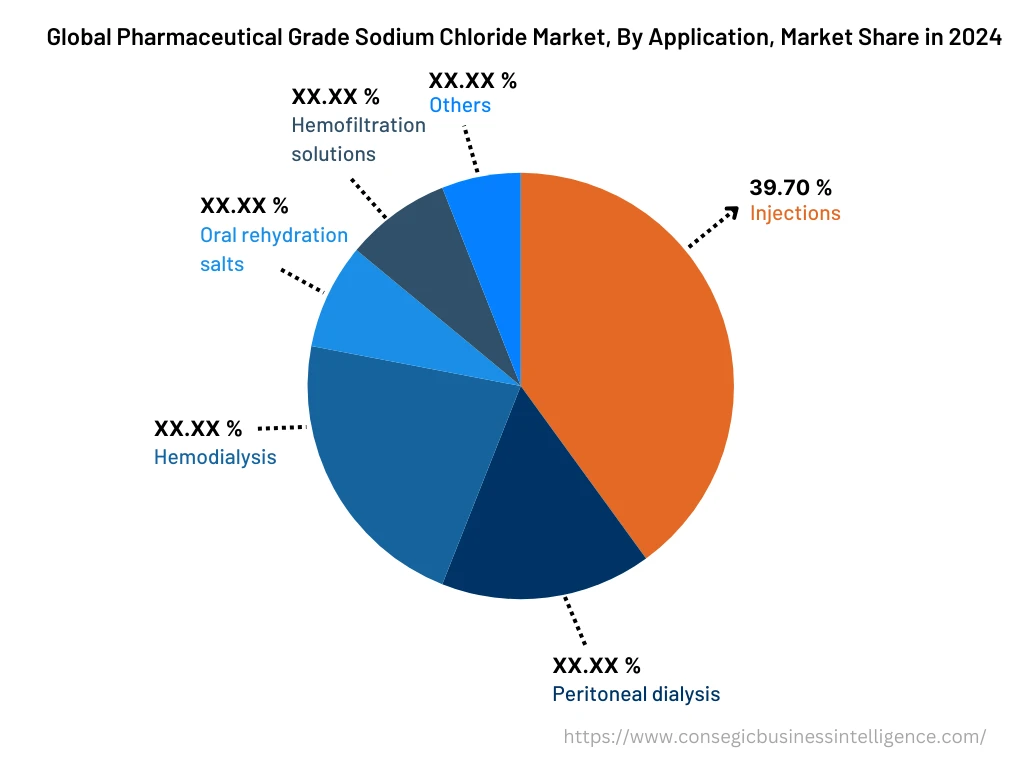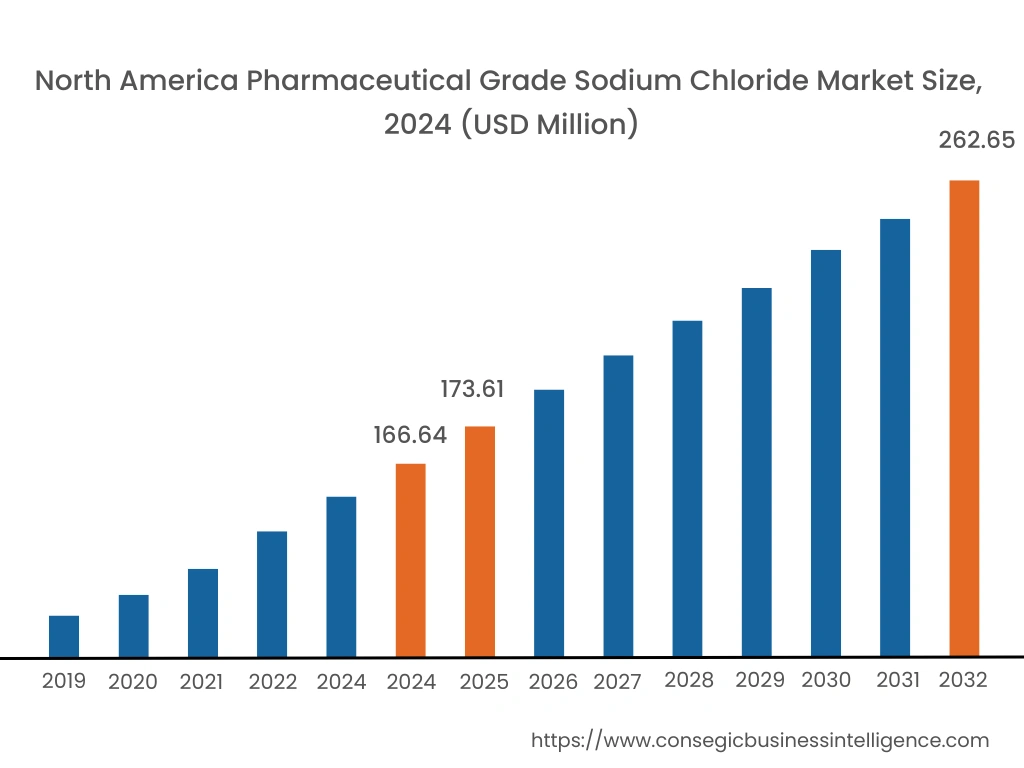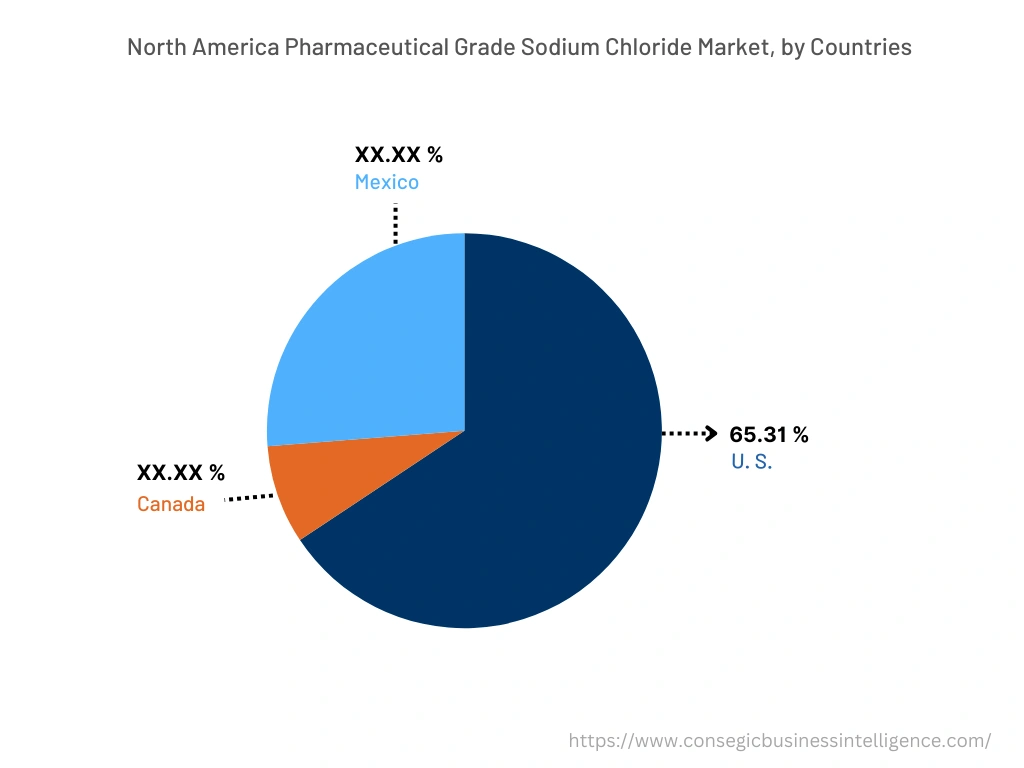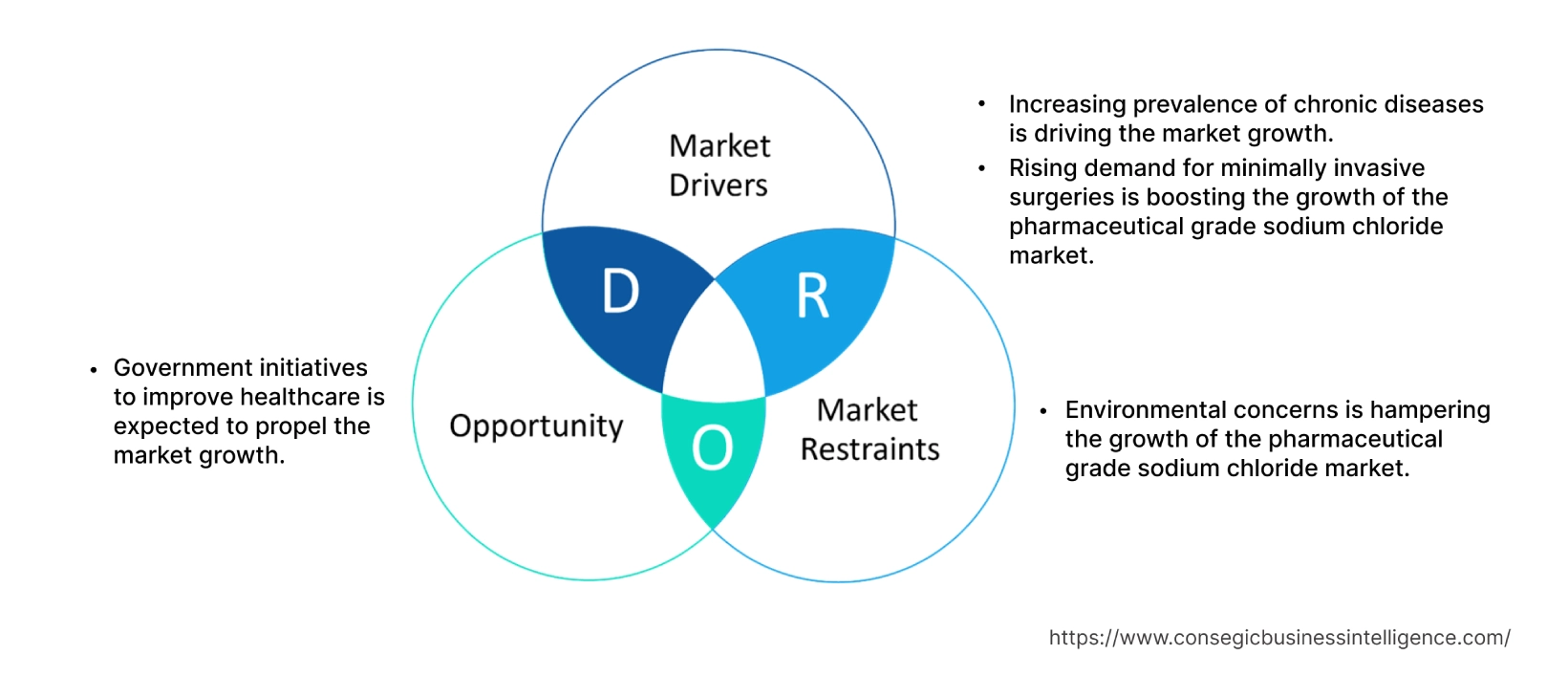Pharmaceutical Grade Sodium Chloride Market Size :
Pharmaceutical Grade Sodium Chloride Market size is estimated to reach over USD 810.4 Million by 2032 from a value of USD 502.38 Million in 2024 and is projected to grow by USD 524.37 Million in 2025, growing at a CAGR of 6.20% from 2025 to 2032.
Pharmaceutical Grade Sodium Chloride Market Scope & Overview:
Pharmaceutical-grade sodium chloride is a highly refined form of sodium chloride that meets strict quality standards for use in pharmaceutical products. It is manufactured under controlled conditions to ensure that it is free of impurities and contaminants that could be harmful to patients. It has several important uses in the pharmaceutical industry. It is used as a diluent for injectable medications, as a component of dialysis solutions, and in the manufacture of oral rehydration salts. It is also used in a variety of other pharmaceutical products, such as topical ointments and nasal sprays. Pharmaceutical-grade sodium chloride is typically supplied in sterile containers to prevent contamination as well. It is an essential ingredient in many pharmaceutical products and plays an important role in the treatment of a variety of diseases and conditions.
Pharmaceutical Grade Sodium Chloride Market Insights :
Pharmaceutical Grade Sodium Chloride Market Dynamics - (DRO) :
Key Drivers :
Increasing prevalence of chronic diseases is driving the market growth
Sodium chloride is used in dialysis solutions to help filter waste products from the blood of people with kidney failure. It is also used in intravenous fluids to help rehydrate people with diabetes who are experiencing dehydration or electrolyte imbalances. Sodium chloride is also used in intravenous fluids to help improve blood pressure and circulation in people with cardiovascular disease. It is also used in the manufacture of many prescription medications that are used to treat chronic diseases. Furthermore, the increasing prevalence of chronic diseases is one of the major drivers of growth in the pharmaceutical-grade sodium chloride market.
Chronic diseases, such as kidney disease, diabetes, and cardiovascular disease, are becoming increasingly common around the world. For instance, according to a report by the Centers for Disease Control and Prevention in 2022, chronic diseases such as heart disease, cancer, and diabetes are the leading causes of death and disability in the U.S. The report also states that the nation's annual healthcare cost was USD 4.1 trillion in 2021. Hence, due to increasing chronic diseases, the pharmaceutical grade sodium chloride market is experiencing significant growth in the market.
Rising demand for minimally invasive surgeries is boosting the growth of the pharmaceutical grade sodium chloride market
Many minimally invasive surgeries require the use of sodium chloride-based solutions. sodium chloride is used to inflate the abdomen during laparoscopic surgery. It is also used to flush fluids and debris from the surgical site during minimally invasive procedures. The rising demand for minimally invasive surgeries is due to several factors such as advances in technology, patient preferences, cost-effectiveness, and others. Minimally invasive surgeries are becoming increasingly popular, as they offer several advantages over traditional open surgery, such as shorter hospital stays, faster recovery times, and less scarring. Hence, due to the aforementioned factors and increasing demand for minimally invasive surgeries, the pharmaceutical grade sodium chloride market is witnessing positive growth in the market.
Key Restraints :
Environmental concerns is hampering the growth of the pharmaceutical grade sodium chloride market
The production of sodium chloride can have a negative impact on the environment. This could lead to stricter environmental regulations, which could increase the cost of producing pharmaceutical-grade sodium chloride. The production of sodium chloride requires a significant amount of water. This can be a problem in areas where water resources are scarce. Also, the production of sodium chloride requires a significant amount of energy. This can contribute to greenhouse gas emissions and climate change. Furthermore, the production of sodium chloride generates huge waste products, including brine and heavy metals. These waste products can pollute the environment if they are not properly disposed of. Hence, due to the high negative impact of the production of sodium chloride on the environment, the pharmaceutical grade sodium chloride market growth is getting hampered.
Future Opportunities :
Government initiatives to improve healthcare is expected to propel the market growth
Governments around the world are investing in healthcare to improve the health of their populations. This is leading to increased demand for pharmaceutical-grade sodium chloride in both public and private healthcare facilities. Governments are also working to expand access to prescription drugs for their citizens. This is leading to increased demand for pharmaceutical-grade sodium chloride, which is used in the manufacture of many prescription drugs. Overall, government initiatives to improve healthcare are a major driver of growth in the pharmaceutical-grade sodium chloride market. As governments invest more in healthcare and expand access to healthcare services, the demand for pharmaceutical-grade sodium chloride is expected to continue to grow.
For instance, according to a report by India Brand Equity Foundation in 2022, in the Union Budget 2023-24, the government allocated USD 10.76 billion to the Ministry of Health and Family Welfare. Hence, due to increasing government initiatives to improve healthcare, the pharmaceutical-grade sodium chloride market is expected to grow significantly in the forecast period.
Pharmaceutical Grade Sodium Chloride Market Report Insights :
| Report Attributes | Report Details |
| Study Timeline | 2019-2032 |
| Market Size in 2032 | USD 810.4 Million |
| CAGR (2025-2032) | 6.2% |
| By Type | API-NaCl and HD-NaCl |
| By Application | Injections, Peritoneal dialysis, Hemodialysis, Oral rehydration salts, Hemofiltration solutions, and Others |
| By Region | North America, Europe, Asia-Pacific, Latin America, and Middle East & Africa |
| Key Players | AkzoNobel, K+S AG, Dominion Salt, Salinen Austria AG, Cargill Incorporated, Sudsalz, Cheetham Salt, Hub Salt, Tata Chemicals, US Salt, Hebei Huachen, and Swiss Saltworks |
Pharmaceutical Grade Sodium Chloride Market Segmental Analysis :
By Type :
The type segment is categorized into API-NaCl and HD-NaCl. In 2024, the HD-NaCl segment accounted for the highest market share and is expected to grow at the fastest CAGR over the forecast period in the pharmaceutical grade sodium chloride market. HD-NaCl is used majorly in hemodialysis solutions. Hemodialysis is a type of dialysis that uses a machine to filter waste products from the blood of people with kidney failure. The HD-NaCl type is widely used in hemodialysis solutions to help draw waste products out of the blood. Also, the increasing prevalence of kidney disease, which is a major chronic disease that affects millions of people worldwide, is boosting larger demand for hemodialysis solutions. For instance, according to a recent report by the National Institute of Diabetes and Digestive and Kidney Diseases in 2022, nearly 808,000 people in the U.S. are living with ESKD, also known as end-stage renal disease (ESRD), with 69% on dialysis and 31% with a kidney transplant. Hence, due to increasing kidney diseases, the segment is witnessing significant growth in the pharmaceutical grade sodium chloride market.
By Application :
The application segment is categorized into injections, peritoneal dialysis, hemodialysis, oral rehydration salts, hemofiltration solutions, and others. In 2024, the injections segment accounted for the highest market share of 39.70% in the pharmaceutical grade sodium chloride market. This is due to the wide range of injectable medications that contain sodium chloride, such as saline solutions, antibiotics, and pain relievers. Injections are the most common form of drug administration, and sodium chloride is used in a variety of injectable medications to help the medication dissolve and be absorbed into the bloodstream. Hence, due to the aforementioned factors, the segment is experiencing positive growth in the pharmaceutical grade sodium chloride market.
Moreover, the hemodialysis segment is expected to grow at the fastest CAGR over the forecast period in the pharmaceutical grade sodium chloride market. Hemodialysis is a type of dialysis that uses a machine to filter waste products from the blood of people with kidney failure. Sodium chloride is used in hemodialysis solutions to help draw waste products out of the blood. Hemodialysis is a life-saving treatment for people with kidney failure. Without hemodialysis, waste products would build up in the blood and eventually become toxic, leading to death. Improved access to hemodialysis treatment, new technological advancements in hemodialysis machines, and growing awareness of the benefits of hemodialysis treatment are acting as catalysts for the growth of hemodialysis. Thus, due to the aforementioned advantages, the segment is witnessing significant growth in the pharmaceutical grade sodium chloride market.

By Region :
The regional segment includes North America, Europe, Asia Pacific, Middle East and Africa, and Latin America.

North America is estimated to reach over USD 262.65 Million by 2032 from a value of USD 166.64 Million in 2024 and is projected to grow by USD 173.61 Million in 2025. In North America, U.S. accounted for the highest market share of 65.31% during the base year 2024. Pharmaceutical grade sodium chloride, also known as sterile saline, is used in a variety of ways to treat kidney diseases. Hemodialysis is a type of dialysis that uses a machine to filter waste products and excess fluid from the blood. Pharmaceutical grade sodium chloride is used to make the dialysate solution, which is the fluid that circulates through the dialyzer and cleanses the blood. The rising prevalence of kidney related disorders across North America is driving market growth across the region. For instance, according to the report by the Center for Disease Control and Prevention in May 2023, about 807,000 Americans are living with kidney failure. Of those, 69% are on dialysis and 31% have a kidney transplant. Hence, due to the aforementioned factors, the pharmaceutical grade sodium chloride market is growing significantly in the region.
Moreover, Asia Pacific is expected to witness significant growth over the forecast period, growing at a CAGR of 6.8% during 2025-2032. Pharmaceutical grade sodium chloride is highly used in pharmaceutical and medical applications. The significant growth in the pharmaceutical industry across the region is expected to provide lucrative growth opportunities for the growth of the market across Asia Pacific. For instance, according to the data published by the Indian Brand Equity Foundation in August 2023, the Indian pharmaceutical industry accounted for USD 50 billion in 2022, which is expected to reach USD 64 billion in 2024. Thus, the significant growth in the pharmaceutical industry across the region is expected to provide lucrative growth opportunities for the market growth in Asia Pacific.

Top Key Players & Market Share Insights:
The Pharmaceutical Grade Sodium Chloride market is highly competitive, with several large players and numerous small and medium-sized enterprises. These companies have strong research and development capabilities and a strong presence in the market through their extensive product portfolios and distribution networks. The market is characterized by intense competition, with companies focusing on expanding their product offerings and increasing their market share through mergers, acquisitions, and partnerships. The key players in the market include-
- Dominion Salt
- Salinen Austria AG
- Cargill Incorporated
- Sudsalz
- Cheetham Salt
- Hub Salt
Recent Industry Developments :
- In August 2023, AkzoNobel has completed the acquisition of the Chinese Decorative Paints business of Sherwin-Williams. The acquisition will further boost the company's position in China and will allow further market segmentation and reinforce their position outside of the premium segment.
- In December 2021, Cargill Incorporated reached an agreement with Croda to acquire the majority of its performance technologies and industrial chemicals business. The investment would dramatically expand Cargill's bio industrial footprint to better serve industrial manufacturers searching for "greener" ingredient solutions.
Key Questions Answered in the Report
What was the market size of the pharmaceutical grade sodium chloride industry in 2024? +
In 2024, the market size of pharmaceutical grade sodium chloride was USD 502.38 million.
What will be the potential market valuation for the pharmaceutical grade sodium chloride industry by 2032? +
In 2032, the market size of pharmaceutical grade sodium chloride will be expected to reach USD 810.4 million.
What are the key factors driving the growth of the pharmaceutical grade sodium chloride market? +
Increasing prevalence of chronic diseases is fueling market growth at the global level.
What is the dominating segment in the pharmaceutical grade sodium chloride by application? +
In 2024, the injections segment accounted for the highest market share of 39.70% in the overall pharmaceutical grade sodium chloride market.
Based on current market trends and future predictions, which geographical region is the dominating region in the pharmaceutical grade sodium chloride? +
North America accounted for the highest market share in the overall pharmaceutical grade sodium chloride.


